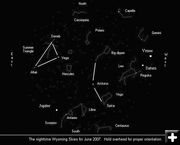Wyoming Skies for June
by Ron Canterna, University of Wyoming Department of Physics and Astronomy
May 30, 2007
A monthly look at the night skies of Wyoming, written by Ron Canterna, professor in the University of Wyoming Department of Physics and Astronomy.
The stars of the "Summer Triangle" beckon the summer season as they have traditionally for over the past millennia. Once dusk subsides, and eyes are adapted to darkness, look to the eastern horizon and see where the three stars Vega, Deneb and Altair make an outline of a fairly large triangle.
Vega is the brightest, whitish star closest to the zenith. Deneb is the second brightest star of the triangle lying on the horizon closer to the north and Altair is the third. All three lie within the Milky Way, which stretches from the southern horizon through the Summer Triangle, then falls off toward the northern cardinal point.
This June after sunset you will see bright-white Venus on the western horizon, followed by Saturn a few degrees toward the zenith. Look toward the southeast and Jupiter will look down on you sky watchers all night. This month Mars rises on the eastern horizon around 2:30 a.m.
June presents a special challenge for you and another chance to see Mercury right after sunset at the beginning of the month.
On the western horizon right after sunset try to find Venus near the two stars of Gemini, Castor and Pollux, which will be about 40 degrees away from the sunset point. Draw an imaginary line from Venus to the sunset point and midway you can then see Mercury with binoculars. In fact, you may be able to see it with your eyes! Summer begins on June 21 this year.
June 2007 Interest: The wandering stars, the planets.
This June is a perfect time to get acquainted with the planets of the solar system. Planet is a Greek word meaning "wandering star" and after dusk, around 9:30 p.m., three noticeable objects will start to appear: The bright, whitish Venus, about 40 degrees above the western horizon; to the north of Venus lies Saturn, and to the southeast right near the horizon is Jupiter.
At the beginning of the month you have a great opportunity to see Mercury. Finally, rising at mid morning is the red planet Mars. All of these planets' positions, with respect to the other stars, will change throughout this month and year.
You need to measure their position to see this movement. Here is a suggestion. Once you locate Venus, Saturn, Mercury, Jupiter and Mars, find their closest two or three easily-recognizable stars. Then, like a surveyor, you need to measure their positions with respect to these stars. You can do this by holding a ruler at arm's length and measuring the "distance" of say Venus from each star. Then you will want to measure the "distances" of the stars and their orientation from each other. Really noticeable this month will be the relative positions of Mercury, Venus and Saturn on the western horizon immediately after sunset.
Sketch this data on a piece of paper. Over the course of June (and July) see how the positions of the planets change and in what direction. You may be very surprised how noticeable these changes are.
You can get more details on the evening skies and a monthly star chart via the Wyoming Skies home page (http://wyoskies.uwyo.edu) or send an e-mail to canterna@uwyo.edu.
|
